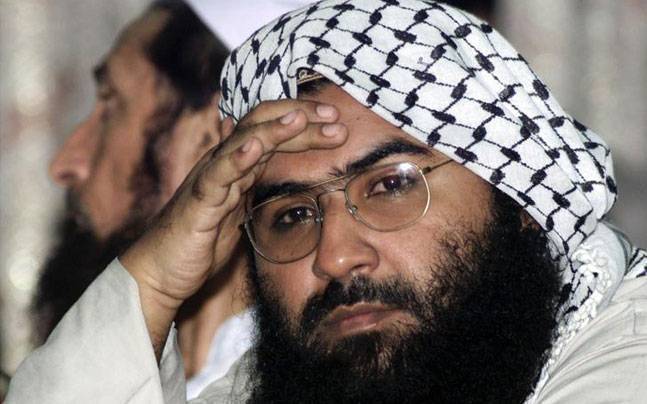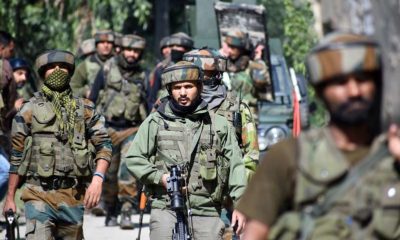Feature
Pakistan military made it clear Masood Azhar’s JeM doesn’t exist in country

Islamabad: The Pakistan military has claimed that Masood Azhar’s Jaish-e-Mohammed (JeM) that claimed responsibility for the Kashmir suicide bombing which killed 40 CRPF personnel “doesn’t exist in the country”.
Major General Asif Ghafoor, the Director General of the Army’s media wing Inter-Services Public Relations (ISPR), made the remarks while talking to English news channel on Tuesday.
Asked if Pakistan will make an “increased effort” in the aftermath of the February 14 Kashmir bombing that was claimed by JeM, Ghafoor said: “First of all, that claim has not been made from within Pakistan because Jaish-e-Mohammad does not (formally) exist in Pakistan. It has been proscribed by the UN (as well as) by Pakistan.”
His remarks were in contrast to the stance of Pakistan Foreign Minister Shah Mehmood Qureshi, who had admitted on February 28 that JeM chief Masood Azhar was in Pakistan and was “unwell to the extent that he cannot leave his house”.
Tensions between India and Pakistan increased following the Kashmir bombing. The incident resulted in mounting pressure from the international community on Islamabad to act on terror groups based on its soil.
Pakistan launched a crackdown against Islamist groups on Tuesday and arrested the brother and son of Masood Azhar along with 42 others affiliated with the banned terror groups. The government also seized properties belonging to Hafiz Saeed’s proscribed Jamaat-ud-Dawa and its charity arm Falah-e-Insaniyat.
“Anybody who operates from Pakistan (against other countries), we feel, that it is not in the interest of Pakistan. Instead of blaming Pakistan, it is time that the world should assist and facilitate Pakistan in getting rid of such organisations,” Ghafoor said.
He, however, added that the country was not taking these measures “under anyone’s pressure”.
The military spokesperson also said that “the ball was now in India’s court” following Islamabad’s “peace gesture” of releasing an Indian Air Force (IAF) pilot but warned that the situation will “go bad” if New Delhi decides to opt for further escalation.
Pakistan military claims Masood Azhar’s JeM doesn’t exist in its country’s territory:
India had retaliated to the Kashmir attack by bombing JeM’s biggest training camp in Balakot, Pakistan. Later, Islamabad captured the IAF Wing Commander after a February 27 dogfight between Indian and Pakistani Air Force. He was released on March 1 as a “peace gesture” by Pakistan.
“We feel that now the ball is in the Indian court. Should they decide to escalate more, the situation will go bad,” Ghafoor told international English news channel.
Asked whether India and Pakistan were close to war, he said: “We were I would say close to war because when they (India) violated the airspace under token aggression, we went for response.
“Now it is up to India whether they take that (IAF pilot release) as a peace gesture and move forward towards de-escalation or continue the agenda that they have.”
Talking about the situation on the Line of Control (LoC), Ghafoor said: “Along the LoC we’re are eyeball to eyeball. There is presence of troops at the LoC for decades. But post the Indian aggression and our response the safeguards have been taken by both side.”
He added that troops had been increased “because it is natural as part of military planning. When the situation gets hot there are safeguards. Those safeguards are in place on both sides”.
Speaking about the Balakot raids, in which New Delhi said that a large number of terrorists were killed, Ghafoor claimed that there were no casualties.
“Their (Indian) claims are false and I believe lately there is an announcement from their side also that they cannot claim any casualty.”
Asked if the Kashmir attack triggered the tensions, Ghafoor said the answer lied in the UN Human Rights Commission report which highlighted “Indian atrocities in occupied Kashmir”.
Entertainment
Meghalaya Reserves Legalized Gambling and Sports Betting for Tourists

The State Scores Extra High on Gaming-Friendly Industry Index
Meghalaya scored 92.85 out of 100 possible points in a Gaming Industry Index and proved to be India’s most gaming-friendly state following its recent profound legislation changes over the field allowing land-based and online gaming, including games of chance, under a licensing regime.
The index by the UK India Business Council (UKIBC) uses a scale of 0 to 100 to measure the level of legalisation on gambling and betting achieved by a state based on the scores over a set of seven different games – lottery, horse racing, betting on sports, poker, rummy, casino and fantasy sports
Starting from February last year, Meghalaya became the third state in India’s northeast to legalise gambling and betting after Sikkim and Nagaland. After consultations with the UKIBC, the state proceeded with the adoption of the Meghalaya Regulation of Gaming Act, 2021 and the nullification of the Meghalaya Prevention of Gambling Act, 1970. Subsequently in December, the Meghalaya Regulation of Gaming Rules, 2021 were notified and came into force.
All for the Tourists
The move to legalise and license various forms of offline and online betting and gambling in Meghalaya is aimed at boosting tourism and creating jobs, and altogether raising taxation revenues for the northeastern state. At the same time, the opportunities to bet and gamble legally will be reserved only for tourists and visitors.
“We came out with a Gaming Act and subsequently framed the Regulation of Gaming Rules, 2021. The government will accordingly issue licenses to operate games of skill and chance, both online and offline,” said James P. K. Sangma, Meghalaya State Law and Taxation Minister speaking in the capital city of Shillong. “But the legalized gambling and gaming will only be for tourists and not residents of Meghalaya,” he continued.
To be allowed to play, tourists and people visiting the state for work or business purposes will have to prove their non-resident status by presenting appropriate documents, in a process similar to a bank KYC (Know Your Customer) procedure.
Meghalaya Reaches Out to a Vast Market
With 140 millions of people in India estimated to bet regularly on sports, and a total of 370 million desi bettors around prominent sporting events, as per data from one of the latest reports by Esse N Videri, Meghalaya is set to reach out and take a piece of a vast market.
Estimates on the financial value of India’s sports betting market, combined across all types of offline channels and online sports and cricket predictions and betting platforms, speak about amounts between $130 and $150 billion (roughly between ₹9.7 and ₹11.5 lakh crore).
Andhra Pradesh, Telangana and Delhi are shown to deliver the highest number of bettors and Meghalaya can count on substantial tourists flow from their betting circles. The sports betting communities of Karnataka, Maharashtra, Uttar Pradesh and Haryana are also not to be underestimated.
Among the sports, cricket is most popular, registering 68 percent of the total bet count analyzed by Esse N Videri. Football takes second position with 11 percent of the bets, followed by betting on FIFA at 7 percent and on eCricket at 5 percent. The last position in the Top 5 of popular sports for betting in India is taken by tennis with 3 percent of the bet count.
Local Citizens will Still have Their Teer Betting
Meghalaya residents will still be permitted to participate in teer betting over arrow-shooting results. Teer is a traditional method of gambling, somewhat similar to a lottery draw, and held under the rules of the Meghalaya Regulation of the Game of Arrow Shooting and the Sale of Teer Tickets Act, 2018.
Teer includes bettors wagering on the number of arrows that reach the target which is placed about 50 meters away from a team of 20 archers positioned in a semicircle.
The archers shoot volleys of arrows at the target for ten minutes, and players place their bets choosing a number between 0 and 99 trying to guess the last two digits of the number of arrows that successfully pierce the target.
If, for example, the number of hits is 256, anyone who has bet on 56 wins an amount eight times bigger than their wager.























